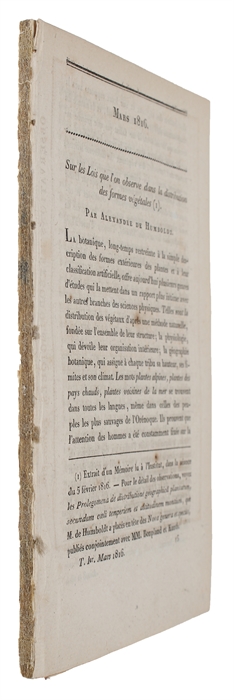FRESNEL, AUGUSTIN. - OVERTHROWING THE CORPUSCULAR THEORY OF LIGHT.
Mémoire Sur la Diffraction de la lumière, où l'on examine particulièrement le phénomène des franges colorées que présentent les ombres des corps éclairés par un point lumineux. (Memoir on the Diffraction of Light....)
(Paris, Crochard, 1816)
No wrappers. In: 'Annales de Chimie et de Physique', Tome I, Sec. Series, Cahier Mars 1816. With htitle to vol. I. Pp. 225-336 and 1 folded engraved plate. (The entire issue offered). Fresnel's paper: pp. 239-281. The plate shows the diffraction patterns.
First appearance of Fresnel's landmark mémoir - this mémoir was his first paper on diffraction, and was later given the prize of the French Academy and published in Memoires de l'Academie in 1826 in full, together with his further developments of his light theory - in which he for the first time explained the causes of the diffraction effects as the mutual interference of the secondary waves emitted by those portions of the original wave-front which have not been obstructed by the diffraction screen. His methods of calculation utilized the principles of both Huygens and Young and he summed the effects due to different portions of the same primary wave-front. The memoir records also Fresnel's famous mirror-experiment.
"In broad context Fresnel's work can be viewed as the first successfull assault on the theory of imponderables and a major influence on the development of nineteenth-centurty energetics." (DSB V, p. 171).
"Augustin Fresnel seems to have adopted a wave theory of light from the very beginning of his studies. His first paper, presented to the Academy...in October 1815, and entitled "La Diffraction de la Lumiere" (the paper offered), was written after a long correspondance with Arago, who had promised Fresnel his full support. "The wave theory" Fresnel wrote, "is well suited to explaining the complicated propagation of light phenomena, and since, as we know from the case of sound, waves can surcomvent obstacles, I decided to make a study of shadows.....It is because they cross in regions common to them both that two pencils of rays can produce fringes. hence it follows that the vibrations of rays which cross at very small angles can cancel out whenever crests of one correspond to the throughs of the other."
Order-nr.: 43910


